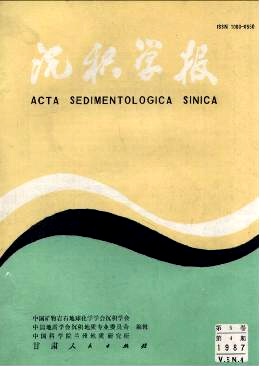CHARACTERISTICS AND GEOLOGICAL SIGNIFICANCE OF SILICEOUS CARBONATE COAL BALLS IN TERTIARY DEPOSITS OF THE CENOZOIC COAL ACCUMULATION BELT IN SOUTH CHINA
- Received Date: 1985-10-23
- Publish Date: 1987-12-10
Abstract: Many siliceous carbonate coal balls, occurring in the lignite seam of some Tertiary coal-bearing basins within the Cenozoic coal-accumulation belt in South China, have been found recently by the authors. They occur in young horizons, distributed extensively and composition varies with areas, but the inner plant structure is preserved vell. They are first reported in China. By extensive observation in the fields and study such as coal petrographic microscope, mineral X-ray powder diffraction, spectrum analysis, petrochemistry and paleobotanic anatomy. It has been proved that the coal ball in the Oligocene-Pliocene lignite seam is specific type of coal ball which mainly consists of silica and carbonate. The mineral consisting of the coal ball vary with the coal-forming conditions such as paleostructure of basin, paleogeography, paleoclimate and paleoplant. The major minerals are quartz, calcite or siderite. The minor and trace minerals are montmorillonite, dolomite and pyrite etc. SiO2 content in the siliceous coal ball is generally more than 66%; CaO content in the calcareous one more than 45%; Fe2O3 content in the ferric one more than 50%; SiO2 content in the ferric-siliceous one more than 76%, FeO more than 7%; CaO content in the ferric-calcareous one more than 23%, Fe2O3+FeO more than 9%. Carbon content in the all kinds of coal balls is generally 13.62%. The contents of the major coal ball-forming elements are about equal to that of the coal seam top, more than those of the lignite, and vary with the kinds of mineral composition of coal balls. But the content of trace element Ti in the coal ball is less than that of the coal seam top, and in prosimity to the lignite. The contents of other trace elements such as Ba, B, Pb, Sn, Ga, Cr, Xi, Mo, Y, Cu, Zn, Zr, Y, Yb, Sr, etc. generally consist with that of the coal seam top and the lignite. All coal balls consist of mineralized coal-forming plants. Their plantic species are mainly Pinus, with minor Pterocarya,, Acer and Fagus etc. The process of the coal balls forming may be summarized as follows: During coal-forming action from stage of peatification to stage of diagenesis, first synsedimentary plant branches underwent oxidation, their woods were gradually decayed and their shape was changed by compression; then the ground water solution, containing the substances of the coal seam top such as silica, calcium and iron, intruded into the coal seam, and the coal-forming plants were filled with and replaced by this mineralized solution, and the coal balls, whose inner structures are well-preserved, were formed. Since these coal balls were found, the following work can be made up for morphological study of Tertiary coalforming plants: Anatomical study of their cell structures, determination of their position in plant classification and reconstruction of their evolutional relation; besides, those are helpful to study coal-forming environments such as paleostructure, paleoclimate and paleogeography.
| Citation: | Tong Yuming, Pen Gelin, Sui Jingxia, Shi Chenglong. CHARACTERISTICS AND GEOLOGICAL SIGNIFICANCE OF SILICEOUS CARBONATE COAL BALLS IN TERTIARY DEPOSITS OF THE CENOZOIC COAL ACCUMULATION BELT IN SOUTH CHINA[J]. Acta Sedimentologica Sinica, 1987, 5(4): 44-55. |






 DownLoad:
DownLoad: